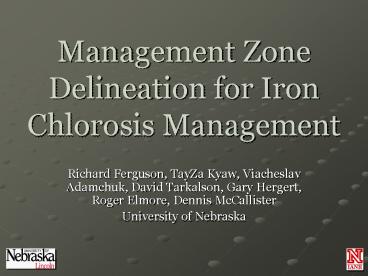Management Zone Delineation for Iron Chlorosis Management - PowerPoint PPT Presentation
1 / 23
Title: Management Zone Delineation for Iron Chlorosis Management
1
Management Zone Delineation for Iron Chlorosis
Management
- Richard Ferguson, TayZa Kyaw, Viacheslav
Adamchuk, David Tarkalson, Gary Hergert, Roger
Elmore, Dennis McCallister - University of Nebraska
2
(No Transcript)
3
Iron Chlorosis
Interveinal chlorosis of leaves, appearing
first on younger plant tissue. Can result from
low soil iron levels, but in Nebraska is
more often due to the plants inability to
effectively utilize iron that is present, either
due to high soil pH, elevated carbonates,
saturated soil or combinations of the above.
4
Iron Chlorosis
5
Why Consider Variable Hybrid Management?
- Over 1 million acres of variably high pH soils in
Nebraska there is also substantial acreage in
Colorado, Kansas and Texas. - Yield potential of corn hybrids vary
significantly with soil pH - yield may be reduced
by 50 for some hybrids on high pH soils. - Hybrids adopted for chlorosis tolerance may yield
less than other hybrids under non-chlorotic
conditions.
6
Study Objectives
- Evaluate options to delineate iron chlorosis
management zones, and assess the stability of
chlorosis-prone areas over years. - Investigate the potential for site-specific
hybrid management to improve overall productivity
in fields with iron chlorosis pressure.
7
Study Area Yield1998
8
Study Area Yield1999
9
Delta Yield - 1998 1999
33V08 - 33R06 Red-Yellow indicates 33V08
(tolerant) yielded better. Blue indicates 34R06
(susceptible) yielded better.
33R87 - 33G26 Red-Yellow indicates 33R87
(tolerant) yielded better. Green-Violet
indicates 33G26 (susceptible) yielded better.
10
Study Locations, 2004-2005
11
Spatial Information Obtained for Each Site
- Grain yield
- Historic DOQQ
- Mapped soil series
- Veris ECa (0-30 cm, 0-90 cm) and pH (15 cm)
- Grid sample pH, EC, Bray-1P, SOM
- Aerial photographs (natural color and NIR)
12
Merrick County Site 1, 2004
13
Merrick County Site 1, 2004-2005
Grid sample points
14
Objective 1. What is the best way to delineate
chlorosis management zones, and are they stable
over time?
Merrick County, Sites 1 and 9
15
Chlorosis Management Zones, Merrick Co., Sites 1
9
Zones delineated with Management Zone Analyst,
Univ. Mo./USDA-ARS
Gray areas have relatively low chlorosis pressure
2004 yield, NDVI and deep ECa
2005 yield, NDVI and deep ECa
2004-2005 yield, NDVI and deep ECa
16
Chlorosis Management Zones, Merrick Co., Site 5
Management zone delineation based on yield, NDVI
and deep ECa.
Chlorosis management zone delineation failed at
this site because another yield- limiting factor
was present (low water-holding capacity).
17
Chase Co. Site 3, 2004
18
Chase Co. Site 3
1999 DOQQ
Chlorosis-prone areas appear stable over time,
and aerial photos are a relatively inexpensive
means of management zone delineation
19
Objective 2. Do hybrids perform differently in
areas of fields with differing chlorosis pressure?
Significant Pearson correlation coefficients
between hybrid yield and soil properties.
Veris pH was not significantly correlated with
yield at any site.
20
Yield reduction due to chlorosis was evident only
at S/Y 1 and 5, both in Merrick Co.
S/Y 1
P34B99 (tolerant)
P34N42 (susceptible)
Yield reduction due to low water-holding capacity
21
S/Y 5, Merrick County Grain Yield
22
S/Y 3, Chase County Grain Yield
23
Summary
- Historic yield, ECa, and aerial imagery can be
useful in delineating chlorosis-prone areas
within fields. - Yield-limiting factors other than chlorosis can
make chlorosis management zone delineation
difficult or not possible. - Aerial imagery appears to be the most
cost-effective means of identifying stable
chlorosis-prone areas. - Site-specific hybrid management within
chlorosis-pressure zones was not feasible with
the two hybrids used in this study, as P34B99
consistently out-yielded P34N42 regardless of the
level of chlorosis pressure. - Site-specific hybrid management could be possible
with hybrids which differ more than those used in
this study.































